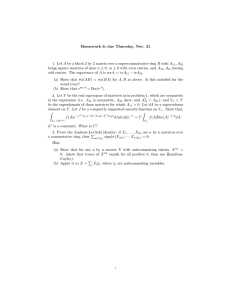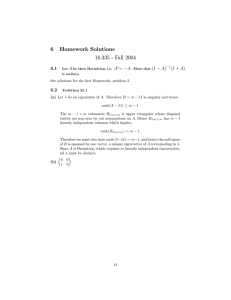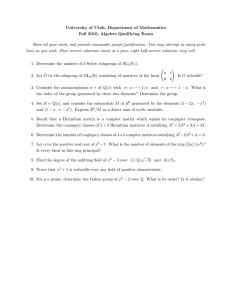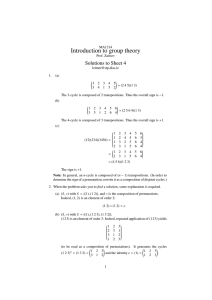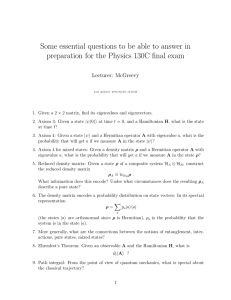Inverse Eigenvalue Problem for a class of Singular Hermitian Matrices
advertisement
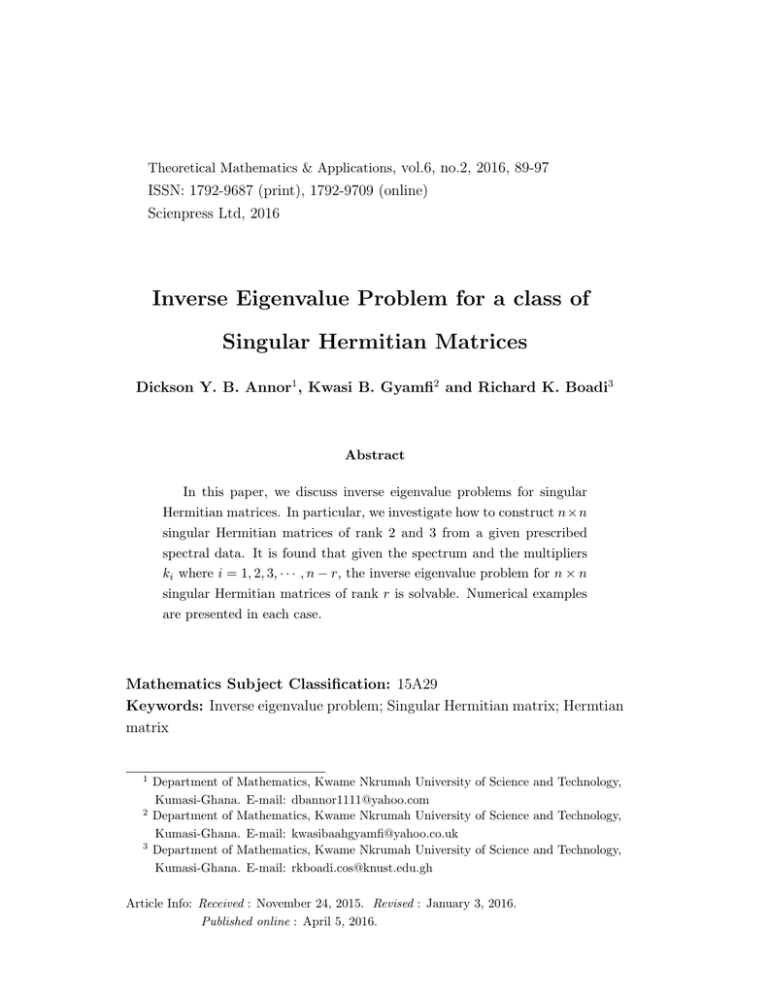
Theoretical Mathematics & Applications, vol.6, no.2, 2016, 89-97
ISSN: 1792-9687 (print), 1792-9709 (online)
Scienpress Ltd, 2016
Inverse Eigenvalue Problem for a class of
Singular Hermitian Matrices
Dickson Y. B. Annor1 , Kwasi B. Gyamfi2 and Richard K. Boadi3
Abstract
In this paper, we discuss inverse eigenvalue problems for singular
Hermitian matrices. In particular, we investigate how to construct n×n
singular Hermitian matrices of rank 2 and 3 from a given prescribed
spectral data. It is found that given the spectrum and the multipliers
ki where i = 1, 2, 3, · · · , n − r, the inverse eigenvalue problem for n × n
singular Hermitian matrices of rank r is solvable. Numerical examples
are presented in each case.
Mathematics Subject Classification: 15A29
Keywords: Inverse eigenvalue problem; Singular Hermitian matrix; Hermtian
matrix
1
2
3
Department of Mathematics, Kwame Nkrumah University of Science and Technology,
Kumasi-Ghana. E-mail: dbannor1111@yahoo.com
Department of Mathematics, Kwame Nkrumah University of Science and Technology,
Kumasi-Ghana. E-mail: kwasibaahgyamfi@yahoo.co.uk
Department of Mathematics, Kwame Nkrumah University of Science and Technology,
Kumasi-Ghana. E-mail: rkboadi.cos@knust.edu.gh
Article Info: Received : November 24, 2015. Revised : January 3, 2016.
Published online : April 5, 2016.
90
1
Inverse Eigenvalue Problem for a class of Singular Hermitian Matrices
Introduction
An Inverse Eigenvalue Problem(IEP ) is to reconstruct a matrix which
possesses both a prescribed eigenvalue and desired structure. Inverse eigenvalue problems arise in broad application areas such as control design, system
identification, principle component analysis, structure analysis etc. There are
many different types of inverse eigenvalue problems and despite of a great deal
of research effort being put into this topic many of them are still open and are
hard to be solved.
In [1] Gyamfi studied the solution to the Inverse Eigenvalue Problems (IEP)
for a class of singular symmetric and singular Hermitian matrices. On the case
of singular Hermitian matrices, he presented results up to rank 1. In this paper,
we extend earlier results found by Gyamfi [1] on the solution to the IEP for a
class of singular Hermitian matrices of rank 1 to rank 2 and 3.
The paper is organised as follows: In section 2 we review basics on how to
reconstruct singular Hermitian matrices of rank 1 from prescribed spectrum.
Our main work on the solution to inverse eigenvalue problems for singular
Hermitian matrices of rank 2 and 3 is presented in section 3. we give conclusion
and recommendation in the fourth section. Readers are referred to Gyamfi [1]
for the details on inverse eigenvalue problems for singular symmetric matrices.
2
Preliminary Notes
In this section we review previous results obtained by Gyamfi [1] in respect
of the inverse eigenvalue problems for singular Hermitian matrices of rank 1.
We begin with with 2 × 2 singular symmetric matrices and extend to n × n
singular hermitian matrices of rank 1.
Lemma 2.1. Let A be a non-traceless, symmetric matrix of rank r with
non-vanishing elements. Then there exits an isomorphism between the elements of A and its distinct non-zero eigenvalues if and only if r = 1.
91
D.Y.B. Annor, K.B. Gyamfi and R.K. Boadi
Corollary 1: The inverse eigenvalue problem has a unique solution for singular symmetric matrices of rank 1 with prescribed linear dependence relation.
Specific case 1:
Given that n = 2, r = 1, we begin by considering A(2,1) . By definition,
A(2,1) has the form:
Ã
A(2,1) =
a11 ka11
ka11 k 2 a11
!
Ã
= a11
1 k
k k2
!
.
Let Λ2 = {λ1 , λ2 }. Since A(2,1) is singular of rank 1, it means that λ2 = 0. We
λ
have tr(A(2,1) ) = λ = a11 + k 2 a11 = a11 (1 + k 2 ). Therefore a11 =
. Hence
1 + k2
Ã
!
1 k
λ
A(2,1) =
.
1 + k2
k k2
Thus A(2,1) has been reconstructed for a given λ and prescribed scalar k.
We see from this formula that for any given λ and parameter k, we can
generate any 2 × 2 singular matrix of rank 1. For example if k = 3, λ = 10 we
have
Ã
!
1 3
A(2,1) =
.
3 9
2.1
Extension to Hermitian matrices
We now extend the above to Hermitian matrices of dimension 2 × 2. A is
Hermitian implies that a21 = a12 . Linear dependence of rows is given by a21 =
ka11 and a22 = ka12 , so that a21 = a12 = ka11 . Then a22 = k(ka11 ) = |k|2 a11 .
We now write the matrix as;
Ã
A(2,1) =
a11
ka11
ka11 |k|2 a11
Ã
!
= a11
1 k
k |k|2
!
.
λ
. ¿From
1 + |k|2
this we see that any 2 × 2 Hermitian matrix which has a parameter with the
Hence tr(A(2,1) ) = λ = a11 + |k|2 a11 = a11 (1 + |k|2 ) =⇒ a11 =
92
Inverse Eigenvalue Problem for a class of Singular Hermitian Matrices
same value as the modulus of k satisfies the above formula.
1
Example: Let k = 1 + 2i, λ = 3 and k = 1 − 2i. We have a11 = and
2
Ã
!
1
1 − 2i
1
A(2,1) =
.
2 1 + 2i
5
We use numerical examples to illustrate small singular Hermitian matrices
os size 3 ≤ n ≤ 4 of rank 1.
Example: For n = 3, r = 1, A(3,1) is the form:
1
k1
k1k2
A(3,1) = a11 k1
|k1 |2
|k1 |2 k 2
k1 k2 |k1 |2 k2 |k1 |2 |k2 |2
λ
. Any parameter which has the same value
1 + |k1 + |k1 |2 |k2 |2
as the modulus of k1 and k2 generates the 3 × 3 singular Hermitian matrix.
3
Suppose λ = 3, k1 = 2i, k 1 = −2i, k2 = 1 + i, k 2 = 1 − i, we have a11 =
and
13
1
−2i −2 − 2i
3
A(3,1) =
2i
4
4 − 4i .
13
−2 + 2i 4 + 4i
8
where a11 =
|2
Example: For n = 4, r = 1. Given k1 , k2 and k3 we obtain the following
singular Hermitian matrix:
1
k1
k1k2
k1k2k3
k
|k1 |2
|k1 |2 k 2
|k1 |2 k 2 k 3
1
A(4,1) = a11
.
2
2
2
2
2
k1 k2
|k1 | k2
|k1 | |k2 |
|k1 | |k2 | k 3
k1 k2 k3 |k1 |2 k2 k3 |k1 |2 |k2 |2 k3 |k1 |2 |k2 |2 |k3 |2
In this case a11 =
λ
|2
1 + |k1 +
|k1 |2 |k2 |2
2i, k2 = 2 + i, k3 = i, we have a11 =
A(4,1)
2
=
45
+ |k1 |2 |k2 |2 |k3 |2
. When λ = 2, k1 =
2
and hence
45
1
−2i
2 − 4i −4 + 2i
2i
4
8 − 4i −4 − 8i
−2 + 4i 8 + 4i
40
−20i
−4 − 2i −4 + 8i 20i
20
.
93
D.Y.B. Annor, K.B. Gyamfi and R.K. Boadi
Proposition 2 : If the row dependence relations for a Hermitian or antiHermitian matrix of rank 1 are specified as follows Ri = ki−1 R1 , i = 2, 3, 4, ..., n−
1 where Ri is the ith row and each ki is a non-zero scalar. The matrix can be
generated from its non-zero eigenvalue λ:
1
k1
k1 k2
..
.
= a11
A(n,1)
k1
|k1 |2
|k1 |2 k2
..
.
k1k2
|k1 |2 k 2
|k1 |2 |k2 |2
..
.
···
k 1 · · · k n−1
· · · |k1 |2 k 2 · · · k n−1
···
···
..
.
k1 · · · kn−1 |k1 |2 · · · kn−1 |k1 |2 |k2 |2 k3 · · · kn−1 · · ·
where
a11 =
3
|2
1 + |k1 +
|k1 |2 |k2 |2
|k1 |2 · · · |kn−1 |2
(1)
λ
.
+ · · · + |k1 |2 × · · · × |kn−1 |2
Main Results
We now consider the IEP for n × n singular Hermitian matrices of rank 2.
A(3,2) is the form:
A(3,2)
a11
ka11
a13
= ka11 |k|2 a11 ka13 .
a13
ka13
a33
Here, tr(A(3,2) ) = λ1 + λ2 = a11 + |k|2 a11 + a33 = a11 (1 + |k|2 ) + a33 . But
λ1 λ2
. Thus
λ1 λ2 = a11 (1 + |k|2 )a33 =⇒ a33 =
a11 (1 + |k|)2
λ1 + λ2 = a11 (1 + |k|)2 +
λ1 λ2
a11 (1 + |k|)2
which implies
a211 (1 + |k|2 )2 − a11 (1 + |k|2 )(λ1 + λ2 ) + λ1 λ2 = 0
94
Inverse Eigenvalue Problem for a class of Singular Hermitian Matrices
λ1
and λ2 = a33 . Therefore a13 becomes a free
1 + |k|2
variable. When λ1 = 1, λ2 = 2, k = 3i and a13 = 2 + i for example, we obtain
the following singular Hermitian matrix:
1
−3i
2
−
i
10
10
3i
9
.
A(3,2) =
3
+
6i
10
10
2 + i 3 − 6i
2
which yields a11 =
We illustrate the results for 4 × 4 singular Hermitian matrices of rank 2.
A(4,2) is of the form:
k 1 a11
k 1 k 2 a11
a14
a11
ka
|k1 |2 a11
|k1 |2 k 2 a11
k1 a14
1 11
A(4,2) =
.
2
2
2
k1 k2 a11 |k1 | k2 a11 |k1 | |k2 | a11 k1 k2 a14
a14
k 1 a14
k 1 k 3 a14
a44
Then tr(A(4,2) ) = λ1 + λ2 = a11 (1 + |k1 |2 + |k1 |2 |k2 |2 ) + a44 . This implies
λ1
a11 =
, λ2 = a44 and a14 becomes a free variable.
2
1 + |k1 | + |k1 |2 |k2 |2
Numerical example, for λ1 = 3, λ2 = 5, k1 = 2i, k2 = 1 + 2i and a14 = 1 + i,
we obtain the singular Hermitian matrix below:
A(4,2)
=
3
25
6i
25
−12+6i
25
1+i
−6i
25
−12−6i
25
1−i
12
12−24i
2
+
2i
25
25
.
12+24i
60
−2 + 6i
25
25
2 − 2i −2 − 6i
5
In general, the solution of the IEP for A(n,r) leads to the solution of an rth
degree polynomial equation in a11 of the form:
95
D.Y.B. Annor, K.B. Gyamfi and R.K. Boadi
0=
ar11 (1
r
X
+ |k1 | + · · · + |kn−r | ) − (
λi )(1 + |k1 |2 + · · · + |kn−r |2 )ar−1
11
2
2 r
i=1
r k+1
X
Y
(
λi )(1 + |k1 |2 + · · · + |kn−r |2 )ar−2
11
k=1 i=k
r k+2
X
Y
−
(
2
λi )(1 + |k1 | + · · · + |kn−r |
2
)ar−3
11
r
Y
+ · · · − ( λi ).
i=1
k=1 i=k
We generalise the method above in the following two theorems, first an
n × n singular Hermitian matrix of rank 2 and the of rank r, where 2 ≤ r < n.
Theorem 3.1. Given the spectrum and the row multipliers ki , i = 1, ..., n −
2, the inverse eigenvalue problem for an n × n singular Hermitian matrix of
rank 2 is solvable.
Proof. Given the spectrum Λn = {λ1 , λ2 , ..., λn }, since the rank of Λ2 = 2, it
follows from our notation above that λ1 6= 0 6= λ2 and λi = 0, for i = 3, 4, ..., n.
Let ki , i = 1, 2, ..., kn−2 be row multiples. Letting
A(n,2)
=
a11
k 1 a11
k 1 k 2 a11
2
k1 a11
|k1 | a11
|k1 |2 k 2 a11
k1 k2 a11 |k1 |2 k2 a11 |k1 |2 |k2 |2 a11
..
..
..
.
.
.
a1n
k 1 a1n
k 1 k 2 a1n
···
k 1 k 2 · · · k n−2 a11
a1n
2
···
|k1 | k 2 · · · k n−2 a11
k1 a1n
· · · |k1 |2 |k2 |2 k3 · · · k n−2 a11 k1 k2 a1n
..
..
···
.
.
···
k 1 k 2 · · · k n−2 a1n
ann
(2)
Then
tr(A(n,2) ) = λ1 + λ2 = a11 (1 + |k1 |2 + |k1 |2 |k2 |2 + · · · + |k1 |2 × · · · × |kn−2 |2 ) + ann .
Hence
a11 =
|2
1 + |k1 +
|k1 |2 |k2 |2
λ1
,
+ · · · + |k1 |2 × · · · × |kn−2 |2
λ2 = ann and a1n becomes a free variable. The result follows by induction on n.
96
Inverse Eigenvalue Problem for a class of Singular Hermitian Matrices
We consider the inverse eigenvalue problem for n × n singular Hermitian
matrices of rank 3. A(4,3) is of the form
A(4,3) =
a11
ka11
a13 a14
2
ka11 |k| a11 ka13 ka14
a13
ka13
a33 a34
a14
ka14
a34 a44
(3)
Here, tr(A(4,3) ) = λ1 + λ2 + λ3 = a11 (1 + |k|2 ) + a33 + a44 . Using equation
(1) A(4,3) leads to the following cubic equation in a11 where λ1 , λ2 and λ3 are
non-zero members of the spectrum.
a311 (1+|k|2 )3 −a211 (1+|k|2 )3 (λ1 +λ2 +λ3 )+a11 (λ1 λ2 +λ1 λ3 +λ2 λ3 )−λ1 λ2 λ3 = 0.
Solving the above cubic equation we obtain the following roots; λ1 = a11 (1 +
λ1
|k|2 ) =⇒ a11 =
, λ2 = a33 and λ3 = a44 , where a13 , a14 and a34 are
1 + |k|2
free variables. For instance, when λ1 = 2, λ2 = −1, λ3 = 5, k = −i, a13 =
2 + i, a14 = 2i and a34 = 1 − 3i we have
A(4,3) =
1
i
2−i
−2i
−i
1
−1 − 2i −2
2 + i −1 + 2i
−1
1 + 3i
2i
−2
1 − 3i
5
.
Finally, we present 5 × 5 singular Hermitian matrix of rank 3. Using the
same method, we obtain the following equation in a11 where λ1 , λ2 and λ3 are
non-zero members of the spectrum.
0 =a311 (1 + |k1 |2 + |k1 |2 |k2 |2 )3 − a211 (1 + |k1 |2 + |k1 |2 |k2 |2 )2 (λ1 + λ2 + λ3 )
+ a11 (1 + |k1 |2 + |k1 |2 |k2 |2 )(λ1 λ2 + λ1 λ3 + λ2 λ3 ) − λ1 λ2 λ3 .
Factoring the above equation gives the following results:
a11 =
1 + |k1
a14 , a15 and a45 .
|2
λ1
, λ2 = a44 and λ3 = a55 . The free variables are
+ |k1 |2 |k2 |2
97
D.Y.B. Annor, K.B. Gyamfi and R.K. Boadi
Example: Let λ1 = 13, λ2 = −3, λ3 = 5, k1 = 2i, k2 = 1 + i, a14 = 4, a15 = i
and a54 = 3 − i, we get the following 5 × 5 singular Hermitian matrix of rank
3:
A(5,3)
=
1
−2i
−2(1 + i)
4
−i
2i
4
4(1 − i)
8i
2
−2(1 − i) 4(1 + i)
8
−8(1 − i) 2(1 + i)
4
−8i
−8(1 + i)
−3
3+i
i
2
2(1 − i)
3−i
5
.
Theorem 3.2. The inverse eigenvalue problem for an n × n singular Hermitian matrix of rank r is solvable provided that n - r arbitrary parameters are
described.
4
Conclusion and recommendation
We found in this study that when the eigenvalues and some parameters are
given the inverse eigenvalue problem for n × n singular Hermitian matrices of
rank 2 and 3 are solvable. To illustrate the results, numerical examples were
provided.
Finally, we recommend that singular Hermitian matrices of rank ≥ 4 could
be studied for future research work.
References
[1] K.B. Gyamfi, Solution of inverse eigenvalue problem of certain singular
Hermitian matrices, PhD thesis, Kwame Nkrumah University of Science
and Technology, Kumasi, 2012.
[2] F.T. Odoru, Solution of the inverse eigenvalue problem for certain (anti)Hermitian matrices using Newton’s method, Journal of Mathematics Research, 6(2), (2014), 1916 - 9795.

